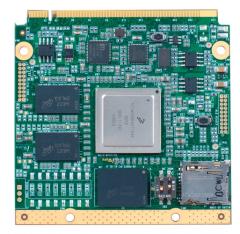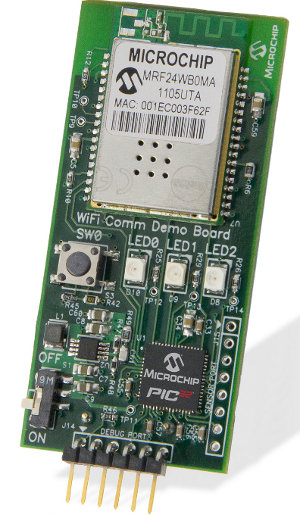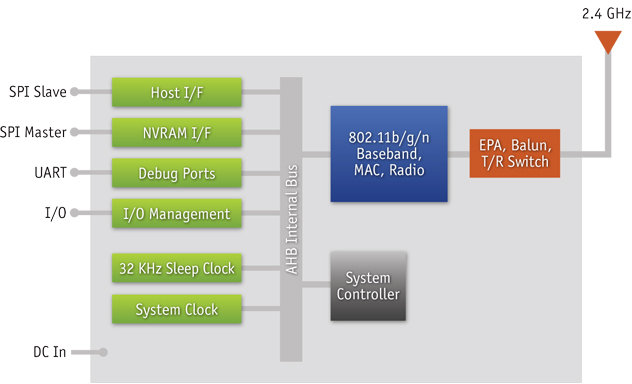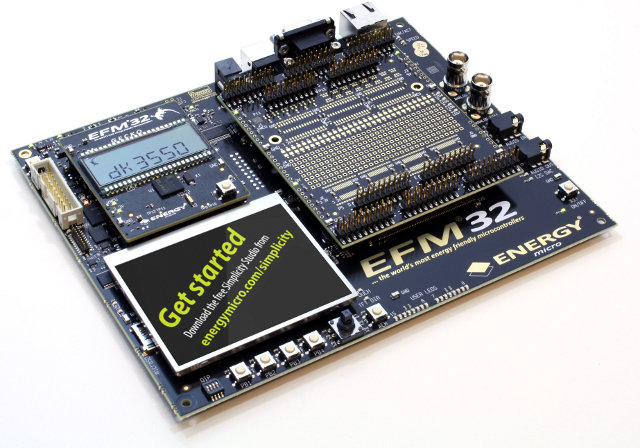grep is a very useful tool to search or filter strings in order to look for files, parse useful info in log files and more. glark is an alternative to grep, it has few features that grep does not such as complex expressions, Perl-compatible regular expressions, and excluding binary files. It also has a more fancy way of display results. It is described as follows in the manpage: Similar to “grep”, “glark” offers: Perl-compatible regular expressions, color highlighting of matches, context around matches, complex expressions (“and” and “or”), grep output emulation, and automatic exclusion of non-text files. Its regular expressions should be familiar to persons experienced in Perl, Python, or Ruby. File may also be a list of files in the form of a path. glark is not installed by default. To install it in Debian/Ubuntu/Mint: sudo apt-get install glark It does not appear to be available in Fedora and […]
iWave Systems Rainbow-G15M-Q7: Qseven SOMs Based on Freescale i.MX 6 Series
iWave Systems, an embedded systems company based in Bangalore, India, has launched Qseven Modules powered by Freescale i.MX 6Quad (quad-core Cortex A9 processor), i.MX 6Duo (dual -core) and i.MX6 Solo. The Rainbow-G15M-Q7 modules are compliant with Qseven specification R1.20 and target the Industrial, Automotive and Medical markets. Here are the modules specifications: CPU: Freescale i.MX6 Cortex A9 Q/D/S core @ 1 GHz Memory: 1GB DDR3 SDRAM– Expandable to 4GB Optional 8GB eMMC Flash On-Board Micro SD slot Qseven Edge Connector : PCIe v2.0 HDMI 1.4 SATA 3.0 Gigabit Ethernet Dual LVDS LCD Support 4 x USB 2.0 Host | 1x USB 2.0 device AC97 Audio 8-Bit SD/MMC CAN1, SPI & I2C ports Debug Port Expansion Connector: 2x Camera CSI MIPI CSI & DSI 24 Bit RGB LCD IF Triple UART 4×4 Key Matrix ESAI (Embedded Software Application Interface) , SPDIF MLB (Media Local Bus), CAN2 I2C, PWM, GPIO, Memory bus Form […]
ARCHOS G9 Tablets Firmware 4.0.5 Released
Two weeks ago, Archos released the first firmware for Archos 80 G9 / 101 G9 and A70B supporting Android 4.0.3 (ICS), so it was likely a new one would soon follow to fix a few bugs. Here’s the ChangeLog: Version 4.0.5 – March 22nd, 2012 Wi-Fi: fix slow throughput and disconnections happening on some access points HDMI: solve no sound or no video output issue on some TVs Bluetooth: make sure Bluetooth does not prevent device suspend VPN: fix VPN connection failing Touchscreen: avoid loss of first finger touch while tapping with second finger The update should be done automatically OTA, but alternatively the firmware can be downloaded at http://update.archos.com/9/gen9/gen9_4.0.5/firmware_archos_it4.aos Jean-Luc Aufranc (CNXSoft)Jean-Luc started CNX Software in 2010 as a part-time endeavor, before quitting his job as a software engineering manager, and starting to write daily news, and reviews full time later in 2011. www.cnx-software.com
Microchip Unveils Wi-Fi Comm Demo Board with 32-bit PIC32 MCU
After TI and Qualcomm, here’s another WiFi solution for MCU aimed at the internet of things (IoT). Yesterday, Microchip Technology announced the Wi-Fi Comm Demo Board, which combines a Microchip 32-bit PIC32 microcontroller (PIC32MX695F512H) with a low-power MRF24WB0MA embedded Wi-Fi radio transceiver module. This small (and cheap) demo board can be used to integrate with existing embedded designs and/or to evaluate Wi-Fi connectivity with a 32-bit MCU. Contrary to TI and Qualcomm, the IP network stack is not implemented in hardware, but Microchip provides a TCP/IP stack that can be freely downloaded at http://www.microchip.com/get/A3VP. This TCP/IP stack includes HTML, DHCP, DNS, IPv4/v6, SSL, etc… (See diagram below) The memory footprint is 28-34 KB depending on the modules used. I could not find details about power consumption, but the company claims their solution can also run with just 2 AAA batteries. Microchip explains that this solution can enable the rapid growth […]
Android SDK Tools and ADT Revision 17 with VM Acceleration for x86 Emulator
Google has released revision 17 of the SDK Tools and the Eclipse plugin. This release brings new features and bug fixes in for Lint static checker, the build system, and the emulator among other things. Here’s what’s new for Lint in r17: Lint API Check – Added check for Android API calls that require a version of Android higher than the minimum supported version. You can use the @TargetApi annotation to specify local overrides for conditionally loaded code. New Lint Rules – Added over 40 new Lint rules for a total of over 80, including checks for performance, XML layouts, manifest and file handling. Ignoring Lint Warnings – Added ability to suppress Lint warnings in Java code with the new @SuppressLint annotation, and in XML files with the new tools: namespace prefix and ignore attribute. New Eclipse Lint UI – Improved HTML and XML reporting and Eclipse integration. Improvements to […]
Qualcomm Atheros AR4100P Provides WiFi Connectivity to the Internet of Things
In January, Texas Instruments was the first company (to my knowledge) to release a WiFi chip for the internet of things, the SimpleLink Wi-Fi CC3000, where WiFi is mostly implemented in hardware to lower power consumption. Now, the company has some competition with the announcement of Qualcomm Atheros AR4100P, an improved version of its AP4100 WiFi chipset, including IPv4/IPv6 support. The AR4100 targets the home, enterprise, smart grid and home automation and control applications that have lower data rates and transmit or receive data on an infrequent basis. The AR4100 system-in-package (SIP) features the following: Low energy Power saving modes as low as 5 µA Wake-up times as low as 2.2 ms Support for Quad SPI flash for faster wake times Low system resource requirements Low footprint host driver (25K Flash and 8K RAM) Simple, low-cost wireless system integration LGA package simplifies 2- or 4-layer PCB design Near zero RBOM […]
Energy Micro Announces EFM32G-DK3550 Gecko (Cortex-M3) Development Kit
Energy Micro has just announced the availability of the EFM32G-DK3550 development kit based on ARM Cortex-M3 EFM32G890F128 MCU. The kit (pictured below) is based on the main board from the bigger Leopard and Giant Gecko kits and supports SEGGER J-Trace and J-Link in order to reduce the need for additional debugging tools. Here are the development kit specifications: EFM32G890F128 Gecko Cortex-M3 MCU 4MB PSRAM 16MB NOR-Flash 320 x 240 RGB resistive touch TFT display Ethernet MAC/PHY microSD slot audio I/O and I2S DAC USB debug interface, SEGGER J-Link debugger Advanced Energy Monitoring (AEM) system to monitor the prototype’s energy consumption. 2x RS232, IrDA Switches, Joystick, LEDs, potentiometer… EXP32 Prototyping area (right side of the picture) For software development, Energy Micro provides Simplicity Studio suite, which includes energyAware Profiler that can interface with the AEM system via USB, gather all relevant system data, and display real-time graphs of current consumption on a […]
Intel Announces Atom CE5300 Media Processor for STBs and Smart TVs
Intel announced the Atom CE5300 Media Processor (codenamed Berryville) to be used in set-top boxes and smart TVs at IPTV World Forum. This new processor is the replacement for CE4100, CE4130 and CE4150 media processors used in the D-Link Boxee Box and Sony NSX-24GT1 Google TV. The Intel Atom CE5300 Media Processor is manufactured using 32nm part and features a dual Intel Atom core with support for hyper-threading and virtualization, an advanced 3D/2D graphics engine, integrated power management, and an H.264 B-picture hardware encoder. That’s all we know for now, as Intel did not provide further information such as a product brief for their new SoC. The Amino Freedom Live Media Gateway, an Hybrid/OTT media gateway powered by the Intel Atom CE5300, is currently showcased at IPTV World Forum. This STB also features the latest Opera TV Browser that support HTML5, JavaScript and WebGL technology among other things. Jean-Luc Aufranc […]








